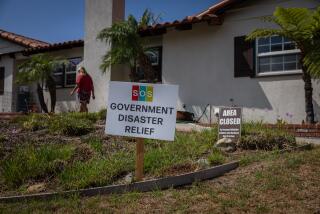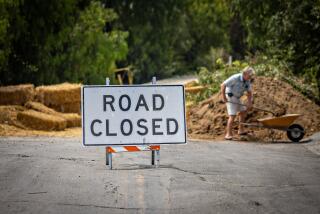Mudslide policies not easy to find
Charred slopes in the foothills towering above William Johnson’s La Canada Flintridge home are now a mudslide in the making after being burned by recent wildfires.
But getting insurance has been impossible for him and many of his neighbors, he said, as winter rains loom.
Johnson, 54, said he called three providers, each of whom said they would not issue insurance for his area.
“While I’m trying to get protection, they don’t want to deal with their losses, and they’re trying to maximize their profits,” he said.
Southland homeowners at a high risk for mudslides say they are finding few options for complete coverage.
Stand-alone mudslide policies are rare, so some residents are buying flood policies on top of fire and earthquake plans, hoping that at least one will accept mudslide damage claims.
But flood insurance is often vague and may not always pay for mudslide damage. Experts say flows that look like a chocolate milkshake tend to be covered, whereas an onslaught with a cake consistency is not.
As a result, residents like Johnson are turning to sandbags as a more reliable defense.
“Ironclad protection probably doesn’t exist,” said California Insurance Commissioner Steve Poizner, who was in La Canada Flintridge on Friday to warn residents of the flooding risk. “There are certain types of perils not addressed by insurance. But there are things homeowners can do to protect themselves other than insurance.”
The Station fire tore through acres of thick vegetation that normally holds the ground in place. The U.S. Geological Survey said this week that communities including Pacoima Canyon, Big Tujunga Canyon and Arroyo Seco could face an 80% chance of mudslides during the rainy season.
La Canada Flintridge and La Crescenta could also be hit.
Poizner, speaking at the base of a hill speckled with dull, ashy dirt and the skeletal remains of trees, said residents were “completely exposed.” Only 20 or so flood policies are in place in the area, according to the Federal Emergency Management Agency.
But basic insurance packages usually don’t cover mudslides, experts said, focusing instead on fire, theft and falling water such as rainstorms.
“A lot of water damage claims end up being duked out in court,” said Amy Bach, executive director of consumer group United Policyholders. “It’s one of these areas where insurance companies have tried in recent years to limit their responsibility.”
Although some providers of basic homeowner plans may be willing to pay for damage if residents can definitively link a mudslide to a recent fire, experts recommended buying a flood policy just in case.
“The last thing you want is to see that water coming and say, ‘Oops, I should have done something,’ ” said Pete Moraga, a spokesman with the Insurance Information Network of California. The nonprofit trade association represents insurers including State Farm, Farmers and Allstate.
The dominant provider, the National Flood Insurance Program, is part of FEMA. Coverage is usually administered locally by independent insurers, few of whom offer their own flood plans.
“Flooding has become such a huge and expensive issue that it became uninsurable,” Moraga said. “Because they usually involve such a large area and such high risk, many companies just pulled out.”
The federal program, created by Congress in 1968, is particular about what damage qualifies for coverage, leaving mudslides in a gray zone.
A flood is defined by the program as a water overflow or an unusual and rapid accumulation or runoff of surface waters, including faulty dams or rivers that jump their banks.
Slope failures are excluded, as are “earth movements” such as earthquakes, sinkholes or gradual erosion. So, too, are landslides that break earth off in large chunks and destabilized land saturated with water.
However, mudflows are covered. The description mentions a river of liquid and flowing mud that picks up debris, usually after rains fall on land without adequate surface vegetation, such as in fire zones.
“The insurance is difficult because of all the flood categories,” said resident Jane Fontana, 47. “If you have a giant rock roll down the hill because of the rain, they don’t really cover that.”
Fontana, a musician whose home in Big Tujunga Canyon was one of only two on her street to survive the Station Fire, said she bought flood insurance as a backup for the fire coverage she has through the California Fair Plan. It is an alternative sponsored by the government and insurance industry offered to those considered too risky by other companies.
Fontana said she was repelled by an initial $2,000 quote -- “a lot of money, especially if I put in a claim and they say no,” she said. Eventually, an agent helped push down the cost to $400.
Just last week, the average cost of the federal flood program rose 8% nationally, according to the Insurance Information Network. On average nationwide, flood policies cost $544 a year, and the average flood claim is $33,000.
In the state, 271,007 federal flood policies are in place, with a total premium of more than $188 million.
For a claim to qualify, two or more acres or properties must be covered in water or mud. But according to the federal program, just 6 inches of flooding can cause more than $11,000 in damage to a house.
The policies usually take effect after 30 days and cover $250,000 in structural damage and up to $100,000 for personal property. Renters’ policies are worth up to $100,000.
In the meantime, experts said homeowners should try to protect their properties by putting out nets, building retaining walls or planting vegetation to divert the mud.
Some insurers also offer additional insurance above the federal program’s limit. And Poizner suggested companies that offer all-inclusive policies or specialized landslide coverage, while cautioning that such plans would be few and far between, and very expensive.
But the combination of home and flood insurance should cover the vast majority of cases, Poizner said.
Some residents, however, are resisting insurance entirely.
Karen Carson, 64, who works for a sports shoe manufacturer, owns the other surviving house on Fontana’s street. She has fire and earthquake insurance but isn’t too concerned about mudslides.
“I’m kind of taking a wait-and-see attitude,” Carson said. “I could be wrong, but I don’t think my actual house is going to be a problem. In 40 years, we’ve had some pretty bad rains, but never a problem with mudslides before.”
--
--
BEGIN TEXT OF INFOBOX
Flood insurance tips
* Contact your insurance agent to determine what exactly your current homeowner insurance policies cover and whether they’re up to date, then assess whether flood insurance is necessary.
* If you need flood insurance, act fast. Policies usually go into effect 30 days after purchase, and the winter rainy season is not far away.
* Ask whether your insurer participates in the National Flood Insurance Program. Or call (888) 379-9531 or visit www.floodsmart.gov. Cost is determined by a region’s flood risk and the age and type of the structure. In low-hazard areas, ask about the discounted Preferred Risk program.
* If you want extra protection on top of the federal program, ask your insurer about supplemental flood coverage or all-inclusive coverage from other sources.
* If you have flood insurance, double-check -- before the rains come -- what is covered, what is not and what information you would need to make claims.
* For other tips on flood insurance claims, visit United Policyholders at www.unitedpolicyholders.org and click on “Claim Tips” and then “Flood” in the left-hand bar.
Source: California Department of Insurance, Times research
More to Read
Sign up for Essential California
The most important California stories and recommendations in your inbox every morning.
You may occasionally receive promotional content from the Los Angeles Times.











